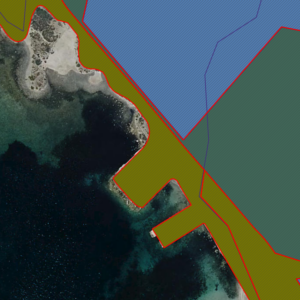Views: 3410
The Port Authority has tendered the construction of a dry dock ramp in the port of Mahon, in a protected area, with no possibility of parking and with the danger of affecting species under special protection. GOB has sent a letter to the port authority warning of these significant deficiencies.
The problem of not carrying out preliminary environmental impact studies in the Port of Mahon
The technical specifications of the tender state that the project has no obligation to undergo any environmental impact study.
GOB disagrees with this interpretation made by the Port Authority, since it is operating on a natural harbor that still holds outstanding natural values in some places. Carrying out a preliminary environmental assessment prevents, for example, cases such as what occurred in Cala Corb, where a protected species was affected when materials were dumped on the seabed to make a construction dock, which has meant a five-year stoppage of the construction.
Previous environmental impact studies serve to prevent, as is the current case, the project of a dry dock ramp over a protected area, where no space for parking vehicles and trailers has been accounted for, and where highly protected marine species can be affected again.
The action is planned on rustic land of special protection
According to the official cartography, the area where action is to be carried out, including the space where the ramp would be built and the area of operations, is rustic land of special protection under the figure of Natural Area of Territorial Interest (ANIT).
It should be remembered that this ANIT carries out the function of ecological connectivity with ANEI lands with a High Protection Level, both to the north and the west and with Natura 2000 Network, specifically with the figure of ZEC-ZEPA.
It seems clear that there is an incompatibility between the land protection regime and the planned contruction works.
No space for parking vehicles and trailers
A dry dock ramp requires areas to maneouver articulated vehicles with trailers and a space where those users can park and have the ability to put their boats to sea.
As mentioned, the ramp that has gone out to tender is proposed on rustic land of special protection, which connects with other lands that are classified as of high level of protection. It does not seem possible to install or enable a car park of the size required by the equipment to be built.
Nor does the Carretera de la Mola appear to be an adequate road to promote the circulation of vehicles and boats of considerable size. Territorial planning serves to put logic into human activities and Cala Teulera does not meet the criteria for locating a facility that attracts vehicles and boats.
Next to marine species under special protection
According to current regulations, the destruction of any species that is on the List of Wild Species under the Special Protection Regime is prohibited.
In Cala Teulera there are several species included in this list:
- Cymodocea nodosa – Considered habitat-forming, these marine phanerogams are protected at national and European level.
- Cystoseira foeniculacea – Algae creating essential habitats for many species of epiphytes, invertebrates and fish.
- Treptacantha barbata – Within the Spanish coast, except for specific places where reintroduction programs have been carried out, this alga is only found in the bays of Fornells and Cala Teulera, therefore, the project would affect a critical area for the species.
- Cladocora caespitosa – Species that is also classified as “endangered” on the IUCN Red List.
- Some species of signatidae – The meadows of Cymodocea nodosa are considered the main habitat of many species of Synnathidae with presence in Cala Teulera, therefore, the project would have an impact on their habitats.
The review of the inventory of protected species offered in the tender project is requested, as well as the realization of a complete environmental impact study, taking into account the natural values present in the area.
Species cannot be relocated without prior authorisation
In the technical specifications of the tender, the presence of two species of special protection (Cymodocea nodosa and Cladocora caespitosa) is confirmed. The proposed solution is that these species will be moved to another location.
As mentioned, the number of protected species is not limited to the two mentioned here, but in any case, a work that can give rights to successful bidders cannot be tendered without having, in advance, express authorizations issued by the competent bodies for each of the affected species, with details of the place of destination and the methodology and agents authorized to do so.
GOB has requested the realization of a detailed inventory of the natural values of the area and, in any case, to have the express authorizations previously issued by the competent bodies for the transfer of each of the species that could be affected.
Environmental legislation is just as mandatory as other legislation. Public bodies must be the first to set an example.



